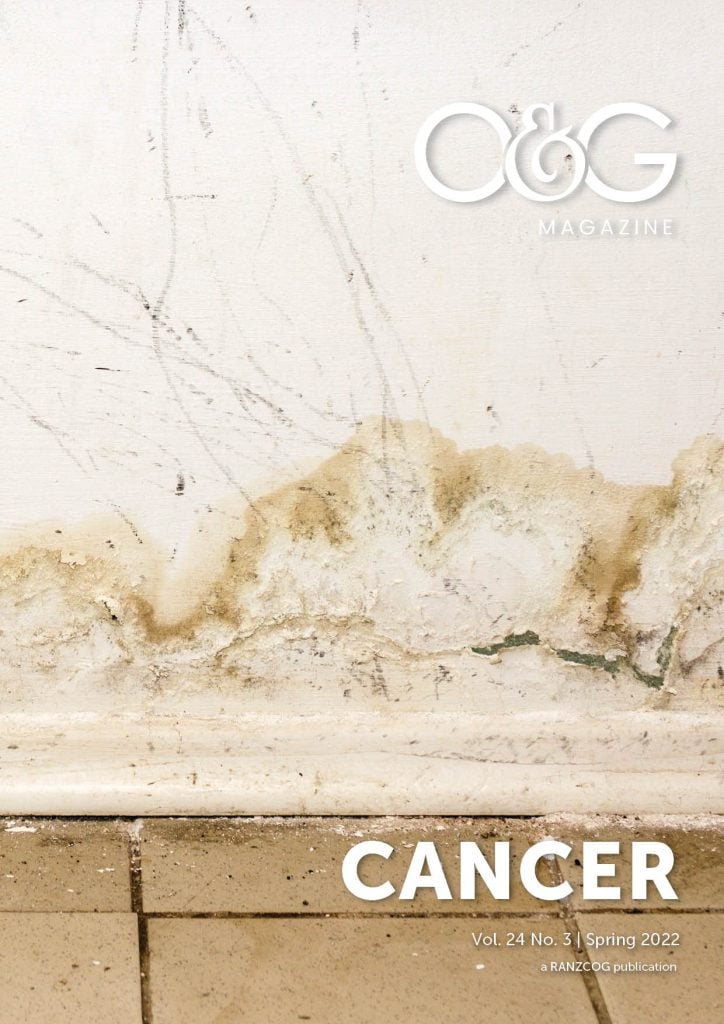Success of the HPV vaccine
Cervix cancer is largely a preventable disease, with human papillomavirus (HPV) being the main cause of high-grade cervix abnormalities and cervix cancer. HPV types 16 and 18 are responsible for 50–60% of high-grade cervical abnormalities and 70% of all cervix cancers.1 2 HPV types 6 and 11 are associated with 90% of anogenital warts.3 HPV vaccination prevents cervix cancer and dysplasia in addition to anogenital and oropharyngeal cancers and genital warts.
A national HPV vaccination program commenced in Aotearoa in 2008, offering vaccination to women born in 1990 and 1991 (aged 17–18 years old) with the quadrivalent HPV vaccine (HPV4) in three doses. A catch-up program was offered in 2009 to all girls and young women aged 9–20 years. From 2017 a further extension of the program included a funded nonavalent HPV vaccination (HPV9) to all females and males aged between 9 and 26 years old. Currently the vaccination program is both primary care and primary school based (targeting all students in year 7 or 8) and more than 300,000 New Zealanders have been immunised against HPV.
In addition to the effect on the individuals immunised, herd immunity will likely have a positive impact to reduce the burden of cervix cancer in Aotearoa for women who are unwilling or unable to receive the vaccination; however, vaccination coverage should surpass 75% to achieve herd immunity. Currently vaccination rates have steadily increased from 39% for the 1990 cohort to 67% for the 2003 cohort,4 but unfortunately still fall short of the herd immunity goal set out by the Ministry of Health. Encouragingly HPV vaccination uptake has been slightly higher and at an increasing yearly rate for at-risk populations including Māori and Pacific Islander wahine compared to other populations in Aotearoa.5 Increasing vaccine uptake has been identified as one of the most effective strategies to reduce cervical cancer disparities and incidence and is a target in the New Zealand Cancer Action Plan 2019–2029. Strategies being explored include changing the HPV vaccination prescription classification to allow pharmacy vaccination, intensified catch-up and recall strategies.
Since the introduction of the HPV vaccine program in 2008, a significant reduction in HPV-vaccine preventable conditions have been seen. In Aotearoa an 83.4% reduction in genital warts was observed five years following the initiation of the program,6 and a 31% reduction in cumulative incidence for high-grade cervix abnormalities was seen between 2011 and 2017.7 This when coupled with the introduction of the HPV9 vaccine in 2017, anticipates a greater reduction of high-grade cervix abnormalities to be observed in Aotearoa.
The effect of the HPV vaccination program is not yet reflected in cervix cancer incidence due to the extended lag time between HPV infection and cancer development, with incidence showing a stable pattern of around 6 per 100,000 women in Aotearoa. International data however have shown a decrease in population incidence of invasive cervix cancer due to vaccination,8 and extrapolating from this, we expect this to translate into a reduction of cervix cancer incidence in Aotearoa.
HPV-based screening
In December 2017 the Australian National Cervical Screening Program was changed to encompass a five-yearly HrHPV primary screening test for women aged 25–74 years, making Australia one of many countries around the world who are performing cervical screening with HrHPV testing +/- reflex liquid based cytology (LBC) as opposed to traditional cervical cytology.
Screening with HrHPV testing has been shown to decrease the incidence and mortality of cervical cancer by 20% and 70% respectively, and a pooled analysis of four European randomised controlled trials of 176,464 women showed that high-risk HPV (HrHPV)-based screening provides a 60–70% greater protection against invasive cervical carcinomas compared with cytology for screening intervals up to five years.9
In regards to the efficacy of this screening test, HrHPV testing alone has a 100% sensitivity in detecting high-grade squamous intraepithelial lesion (HSIL), this is compared with a 68% sensitivity for conventional smears and 87% for LBC.10 When considering whether to screen with HrHPV testing in isolation, or to combine it with LBC, a co-test, this question was answered by the ATHENA study (n=42 209), whereby HrHPV primary screening was as effective as hybrid screening, but required less screening tests to be done.11
The role of LBC comes into play in the triaging of HrHPV screening tests, as the high sensitivity of HrHPV testing comes at the expense of a lower specificity and positive predictive value (PPV) when compared with cytology and hence when used in isolation HrHPV testing increases the burden on colposcopy services. In HrHPV positive women, LBC has been shown to minimise overtreating and unnecessary follow up through increasing the tests specificity and PPV.
Another advantage of HrHPV screening is the increased screening interval of five years, which has been shown to be safe, due to its high negative predictive value (NPV), whereby the risk of HSIL at six years following a negative screening being been shown to be less than 1%.12 Concerns have been raised regarding an increased screening age of 25 years. However, cancers are rare in this age group whereas HPV infections are common and therefore screening is likely to lead to overtreatment, and in addition to this, this cohort is likely to be vaccinated conferring them additional protection.
As such a move to screening with HrHPV testing is not only backed by robust evidence but will lead to higher detection of cancers with less overtreatment of women.
The current Aotearoa screening program
Currently in Aotearoa the National Cervical Screening Program (NCSP) comprises three-yearly smears after coitarche from the age of 25–69 years, with over 73% of eligible women having regular smear tests in recommended time frames.13 Reflex HrHPV testing can then be used to triage women ≥30 with a low-grade squamous intraepithelial lesion (LSIL) or atypical squamous cells of undetermined significance (ASC-US) smear who have previously had a normal smear.
The NCSP has been hugely successful with the number of women dying from cervical cancer falling 60% since the NCSP began in 1990; however, this reduction has been inequitable with Māori wahine being less likely to be screened and being twice as likely to develop and die of cervical cancer than their pakeha counterparts.14
In line with Australia and robust international data, there is now a planned move to screening with HrHPV in July 2023, with the option of self-testing for all women being available. Studies undertaken in Aotearoa have suggested the option of self-testing is likely to increase participation and equitable outcomes by reducing barriers to screening and increasing access; with ongoing research being undertaken to assess the best way to invite wahine to participate in screening including GP-led opportunistic screening, telehealth and mail-out systems and invitation via Māori and Pacific health partners in community settings.
In line with Australia, it is hoped that this new screening approach will be both efficacious and acceptable to women. In addition to this, it is hoped that a culturally appropriate and acceptable approach to inviting women to participate in cervical screening, coupled with the option of HPV self-testing, may reduce the gap in outcomes and improve equity in Aotearoa wahine in the future.
Our feature articles represent the views of our authors and do not necessarily represent the views of the Royal Australian and New Zealand College of Obstetricians and Gynaecologists (RANZCOG), who publish O&G Magazine. While we make every effort to ensure that the information we share is accurate, we welcome any comments, suggestions or correction of errors in our comments section below, or by emailing the editor at [email protected].
References
- Smith JS, et al. Human papillomavirus type distribution in invasive cervical cancer and high-grade cervical lesions: a meta-analysis update. Int J Cancer. 2007;121(3):621-32.
- Simonella LM, et al. Type-specific oncogenic human papillomavirus infection in high grade cervical disease in New Zealand. BMC Infect Dis. 2013;13:114.
- Garland SM, et al. Natural history of genital warts: analysis of the placebo arm of 2 randomized phase III trials of a quadrivalent human papillomavirus (types 6, 11, 16, and 18) vaccine. J Infect Dis. 2009;199(6):805-14.
- Health M. HPV immunisation coverage December 2017. Available from: tewhatuora.govt.nz/assets/For-the-health-sector/Health-sector-guidance/Vaccine-information-for-healthcare-professionals/Downloads/HPV-immunisation-coverage-by-birth-cohort-19902003-as-at-31-Dec-2017-pdf-28-KB.pdf.
- Health M. HPV immunisation coverage December 2017. Available from: https://www.tewhatuora.govt.nz/assets/For-the-health-sector/Health-sector-guidance/Vaccine-information-for-healthcare-professionals/Downloads/HPV-immunisation-coverage-by-birth-cohort-19902003-as-at-31-Dec-2017-pdf-28-KB.pdf.
- Oliphant J, et al. Trends in genital warts diagnoses in New Zealand five years following the quadrivalent human papillomavirus vaccine introduction. N Z Med J. 2017;130(1452):9-16.
- Goyani AD, et al. Trends in the diagnosis of high-grade cervical abnormalities in young women in the post-vaccination era. N Z Med J. 2020;133(1524):50-63.
- Lei J, et al. HPV Vaccination and the Risk of Invasive Cervical Cancer. N Engl J Med. 2020;383(14):1340-8.
- Ronco G, et al. Efficacy of HPV-based screening for prevention of invasive cervical cancer: follow-up of four European randomised controlled trials. Lancet. 2014;383(9916):524-32.
- Clavel C. et al. Human papillomavirus testing in primary screening for the detection of high-grade cervical lesions: a study of 7932 women. Br J Cancer. 2001;84(12):1616-23.
- Wright TC, et al. Primary cervical cancer screening with human papillomavirus: end of study results from the ATHENA study using HPV as the first-line screening test. Gynecol Oncol 2015;136(2):189-97.
- Russo M, et al. Acquired Resistance to the TRK Inhibitor Entrectinib in Colorectal Cancer. Cancer Discov. 2016;6(1):36-44.
- Programme NCS. Changing the primary laboratory test. 2016; Available from: www.nsu.govt.nz/system/files/page/consultation_summary.docx.
- Programme NCS. Changing the primary laboratory test. 2016; Available from: www.nsu.govt.nz/system/files/page/consultation_summary.docx.







Leave a Reply